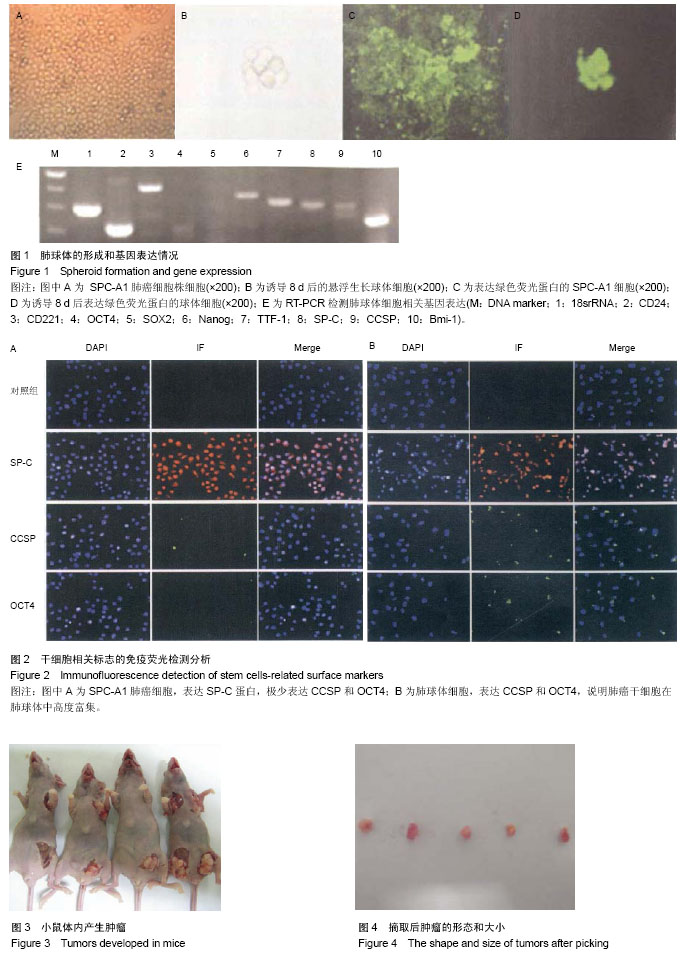| [1] 梁冬,马秀梅.人肺癌干细胞分离培养及鉴定的实验研究[J].医学信息:中旬刊,2011,24(5):1718-1719.
[2] 月文科,焦锋,刘彬,等.人大细胞肺癌干细胞样细胞的富集及其功能研究[J].中国肺癌杂志,2011,14(6):484-491.
[3] Kim EK, Li G, Lee TJ, et al. The effect of human adipose-derived stem cells on healing of ischemic wounds in a diabetic nude mouse model. Plast Reconstr Surg. 2011; 128(2):387-394.
[4] 张瑞山. CD44+/CD24-表型乳腺癌细胞的干性研究以及干细胞相关因子Oct-4在乳腺癌中的表达和临床意义[D].沈阳:中国医科大学,2010.
[5] 谢国柱.通过对肿瘤细胞致瘤潜能及上皮—间充质转化的研究探讨肿瘤干细胞假说的本质[D].广州:南方医科大学,2012.
[6] Hölsken A, Stache C, Schlaffer SM, et al. Adamantinomatous craniopharyngiomas express tumor stem cell markers in cells with activated Wnt signaling: further evidence for the existence of a tumor stem cell niche. Pituitary. 2014;17(6): 546-556.
[7] 杨帆,常锐,周清华,等. 表皮细胞生长因子受体酪氨酸激酶抑制剂(EGFR-TKIs)抑制肺癌肿瘤干细胞样细胞群的机制研究[C].长春:第13届全国肺癌学术大会论文集,2013:351-353.
[8] 许峰,张雷,潘晋坤,等.骨髓间充质干细胞参与A549肺腺癌的组织修复[J].中国组织工程研究,2013,17(32):5749-5756.
[9] 易恒仲,龙灵芝,周源,等.LY294002抑制小细胞肺癌干细胞样细胞自我更新[J].湖南师范大学学报:医学版,2013,10(1):15-18.
[10] 徐瑜.耐药肺癌干细胞的分离、鉴定及多梳家族成员Bmi-1对其更新和增殖的调控[D].重庆:第三军医大学,2011.
[11] Gidwani P, Levy A, Goodrich J, et al. Successful outcome with tandem myeloablative chemotherapy and autologous peripheral blood stem cell transplants in a patient with atypical teratoid/rhabdoid tumor of the central nervous system. J Neurooncol. 2008;88(2):211-215.
[12] 张海燕,李卫红,马鸿儒,等.肿瘤坏死因子抑制人肺癌细胞增生能力的体外研究[J].首都医科大学学报,2000,21(1):20-22.
[13] 高全立,汪萍,Gunnar Kvalheim,等.TGF-β1对肺癌干细胞和非干细胞增殖的影响[J].中国肿瘤生物治疗杂志,2010,17(4): 374-380.
[14] 乐涵波,刘晓光,曾芳.人肺癌NCI-H446细胞生成肿瘤干细胞球[J].解剖学报,2012,43(4):500-505.
[15] 王伟,李勇,牛旗.从耐顺铂肺腺癌A549/DDP细胞系分离和鉴定肺癌干细胞的研究[J].中华临床医师杂志:电子版,2012,6(22): 7229-7232.
[16] 郑必强,周瑾,耿沁,等.人肺腺癌干细胞源自肺脏细支气管肺泡干细胞的初步研究[J].中国肺癌杂志,2008,11(6):759-764.
[17] 王光辉.反义肽核酸封闭线粒体DNA转录启动子对肺癌细胞/肺癌干细胞生物学特性影响的初步研究[D]. 重庆:第三军医大学, 2009.
[18] 刘哲亮,肖高明,陈跃军,等.肺癌干细胞与肺癌的发生[J].中国组织工程研究,2014,18(28):4568-4572.
[19] 谢爱民.Notch1及Bmi-1在肺癌干细胞中表达的相关性及临床意义[J].实用医学杂志,2014,30(7):1104-1106,1107.
[20] Deng S, Yang X, Lassus H, et al. Distinct expression levels and patterns of stem cell marker, aldehyde dehydrogenase isoform 1 (ALDH1), in human epithelial cancers. PLoS One. 2010;5(4):e10277.
[21] 蔡华荣,江跃全.多肽修饰载紫杉醇脂质体靶向A549肺癌干细胞的研究[J].中国生化药物杂志,2014,35(4):12-14,18.
[22] 赵欣.载microRNA-34a脂质体靶向治疗肺癌干细胞靶的研究[J].中国生化药物杂志,2014,35(1):68-71.
[23] 冯晓延,杜振宗.肺干细胞、肺癌干细胞与肺癌[J].中国组织工程研究,2012,16(32):6053-6057.
[24] 李小江,张文治,张莹,等.肺癌干细胞的影响机制研究进展[J].中国肿瘤临床,2012,39(9):619-622.
[25] 肖桦,秦旭华,赖宇,等.西黄丸含药血清经Wnt信号转导通路细胞周期蛋白D1调控人肺癌干细胞增殖的机制[J].中国实验方剂学杂志,2014,20(15):172-176.
[26] Sullivan JP, Spinola M, Dodge M, et al. Aldehyde dehydrogenase activity selects for lung adenocarcinoma stem cells dependent on notch signaling. Cancer Res. 2010;70(23): 9937-9948.
[27] Janikova M, Skarda J, Dziechciarkova M, et al. Identification of CD133+/nestin+ putative cancer stem cells in non-small cell lung cancer. Biomed Pap Med Fac Univ Palacky Olomouc Czech Repub. 2010;154(4):321-326.
[28] 张丽丽,林育红.肺癌干细胞基因Oct-4表达的临床意义[J].中国医药导报,2013,10(14):22-25.
[29] 赵雅瑞,张立凡,刘特,等.姜黄素上调caspase-3和p53表达后对人肺癌干细胞增殖与侵袭的影响[J].中国临床医学,2013,20(3): 259-262.
[30] 高全立,汪萍,Gunnar Kvalheim,等.大细胞肺癌干细胞样细胞的分离及鉴定[J].中国肿瘤生物治疗杂志,2010,17(3):274-279.
[31] 付军科,吴齐飞,张勇.Id1在人肺癌细胞系A549肿瘤细胞球中的表达[J].现代肿瘤医学,2012,20(12):2483-2485.
[32] 陈寅.CD133作为肺癌干细胞标记物的应用及其局限性[J].中国肺癌杂志,2011,14(10):825-829.
[33] Nardone A, Corvigno S, Brescia A, et al. Long-term cultures of stem/progenitor cells from lobular and ductal breast carcinomas under non-adherent conditions. Cytotechnology. 2011;63(1):67-80.
[34] 张浩,沈振亚,王雷,等.细胞集落刺激因子诱导肺癌干细胞分化的临床应用[J].江苏医药,2012,38(9):1071-1072.
[35] 张立凡,刘特.小干扰RNA抑制成纤维细胞激活蛋白3的表达对肺癌干细胞增殖和侵袭的影响[J].中国临床医学,2013,20(1):5-7.
[36] Gentles AJ, Plevritis SK, Majeti R, et al. Association of a leukemic stem cell gene expression signature with clinical outcomes in acute myeloid leukemia. JAMA. 2010;304(24): 2706-2715.
[37] 徐海能. 组织特异性及靶向癌症干细胞的基因—病毒治疗;Ⅰ组织特异性靶向肝癌的基因—病毒治疗;Ⅱ靶向肺癌干细胞和肺癌干细胞表面标志的研究;Ⅲ乙酰胆碱酯酶在基因—病毒治疗系统中的应用[D].北京:中国科学院大学,2013.
[38] 蒋娟,易亭伍,张瑜,等.非小细胞肺癌的肿瘤干细胞与非肿瘤干细胞中表皮生长因子受体基因异质性的研究[J].第三军医大学学报, 2012,34(20):2039-2042.
[39] Dontu G, Abdallah WM, Foley JM, et al. In vitro propagation and transcriptional profiling of human mammary stem/progenitor cells. Genes Dev. 2003;17(10):1253-1270.
[40] Dontu G, Wicha MS. Survival of mammary stem cells in suspension culture: implications for stem cell biology and neoplasia. J Mammary Gland Biol Neoplasia. 2005;10(1): 75-86. |

.jpg)